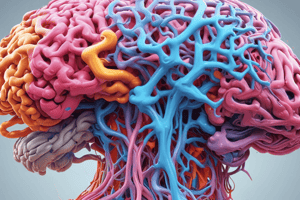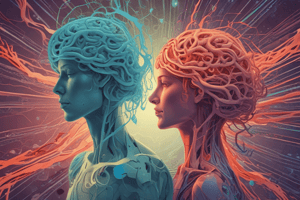Podcast
Questions and Answers
Which medication is often used to manage tics by slowing down sudden movements?
Which medication is often used to manage tics by slowing down sudden movements?
- Clonazepam (correct)
- Sertraline
- Lithium
- Fluoxetine
What type of movements are characteristic of Tourette's Syndrome?
What type of movements are characteristic of Tourette's Syndrome?
- Shuffling gait
- Abrupt, stereotypical movements (correct)
- Sustained muscle contractions
- Random jerking movements
Which feature is commonly associated with Parkinson's disease along with a shuffling gait?
Which feature is commonly associated with Parkinson's disease along with a shuffling gait?
- Involuntary vocalization
- Resting tremor (correct)
- Uncontrolled muscle spasms
- Dystonic posturing
What type of involuntary movements is associated with Huntington's disease?
What type of involuntary movements is associated with Huntington's disease?
Which condition is best described by sustained muscle contractions, repetitive twisting, and abnormal posturing?
Which condition is best described by sustained muscle contractions, repetitive twisting, and abnormal posturing?
What is the primary treatment goal for managing tics?
What is the primary treatment goal for managing tics?
What is the Kayser-Fleischer Ring an indicator of?
What is the Kayser-Fleischer Ring an indicator of?
Which of the following is a cause of secondary dystonia?
Which of the following is a cause of secondary dystonia?
What type of dystonia affects only specific body parts?
What type of dystonia affects only specific body parts?
What characterizes myoclonus compared to dystonia?
What characterizes myoclonus compared to dystonia?
Which of the following conditions can induce chorea-like movements?
Which of the following conditions can induce chorea-like movements?
What distinguishes focal dystonia from segmental dystonia?
What distinguishes focal dystonia from segmental dystonia?
Which type of brain injury can cause myoclonus?
Which type of brain injury can cause myoclonus?
What is the main pathophysiological problem leading to dystonia?
What is the main pathophysiological problem leading to dystonia?
What type of movement disorder is characterized by involuntary abrupt, irregular movements of the body?
What type of movement disorder is characterized by involuntary abrupt, irregular movements of the body?
Which condition is associated with chorea due to basal ganglia damage?
Which condition is associated with chorea due to basal ganglia damage?
Which type of tremor is typically seen at rest, particularly in conditions like Parkinson's disease?
Which type of tremor is typically seen at rest, particularly in conditions like Parkinson's disease?
What can be inferred if a patient exhibits both hypokinetic and hyperkinetic symptoms?
What can be inferred if a patient exhibits both hypokinetic and hyperkinetic symptoms?
Which of the following best describes hyperkinetic movement disorders?
Which of the following best describes hyperkinetic movement disorders?
In what way is the classification of movement disorders critical?
In what way is the classification of movement disorders critical?
What is a common cause of chorea related to copper metabolism?
What is a common cause of chorea related to copper metabolism?
Which statement is true regarding action tremors?
Which statement is true regarding action tremors?
Flashcards are hidden until you start studying
Study Notes
Overview of Movement Disorders
- Classified as hyperkinetic (excessive movement) or hypokinetic (reduced movement).
- Hyperkinetic disorders: include tremors, chorea, dystonia, myoclonus, tics, and stereotypical movements.
- Patients can show mixed symptoms from both categories, exemplified by Parkinson's disease presenting with shuffling gait (hypokinetic) and resting tremors (hyperkinetic).
- Classification is essential for accurate diagnosis and management.
Tremors
- Classified based on behavior patterns and observation during specific actions.
- Types:
- Resting tremors: prevalent in conditions like Parkinson's disease.
- Action tremors: associated with cerebellar lesions, found in essential tremors.
- Differential diagnosis relies heavily on identifying the tremor type for effective management.
Hyperkinetic Movement Disorders
Chorea
- Characterized by involuntary, abrupt, and irregular body movements.
- Pathophysiology involves basal ganglia damage, disrupting motor control.
- Associated Conditions:
- Huntington's Disease: caused by CAG repeat expansion affecting basal ganglia.
- Wilson's Disease: copper metabolism disorder, leads to chorea with Kayser-Fleischer ring around the iris.
- Drug-induced chorea: often consequence of neuroleptics or dopaminergic medications.
- Toxic exposures: ethanol and carbon monoxide can result in chorea-like movements.
- Thyrotoxicosis: hyperthyroidism can also induce similar movements.
- Immunological disorders: SLE and post-streptococcal conditions related to chorea development.
Dystonia
- Defined by sustained muscle contractions resulting in repetitive twisting or abnormal postures.
- Pathophysiology involves basal ganglia dysfunction disrupting motor commands.
- Types:
- Focal Dystonia: affects a specific area (e.g., blepharospasms, spasmodic dysphonia).
- Segmental Dystonia: impacts adjacent regions.
- Generalized Dystonia: affects multiple areas throughout the body.
- Causes:
- Idiopathic Dystonia: no identifiable cause, includes torsion dystonia linked to genetics.
- Secondary Dystonia: stems from cerebral issues, neurodegeneration, hypoxic injury, and drug-related causes.
Myoclonus
- Sudden, lightning-like muscle contractions, typically brief and abrupt.
- Quick like dystonia but characterized by distinct muscle contractions.
- Causes range from physiological factors and epilepsy to metabolic disorders and brain trauma.
- Management often includes benzodiazepines (e.g., clonazepam) and antiepileptics (e.g., valproate) to reduce the frequency and intensity of movements.
Tics
- Abrupt, coordinated, repetitive movements or sounds.
- Suppression of tics can lead to anxiety, commonly observed in Tourette’s syndrome.
- Coprolalia refers to involuntary swearing or inappropriate remarks in some patients with Tourette's.
- Management strategies focus on behavioral therapies and medications, depending on severity.
Clinical Considerations
- A 75-year-old with a shuffling gait may also exhibit resting tremors, indicating a possible diagnosis of Parkinson's disease.
- Huntington disease is identified by abrupt onset chorea, characterized by irregular movements flowing unpredictably through the body.
- Wilson disease may present as sustained muscle contractions and abnormal posturing, typically classified as hyperkinetic secondary dystonia.
Studying That Suits You
Use AI to generate personalized quizzes and flashcards to suit your learning preferences.




